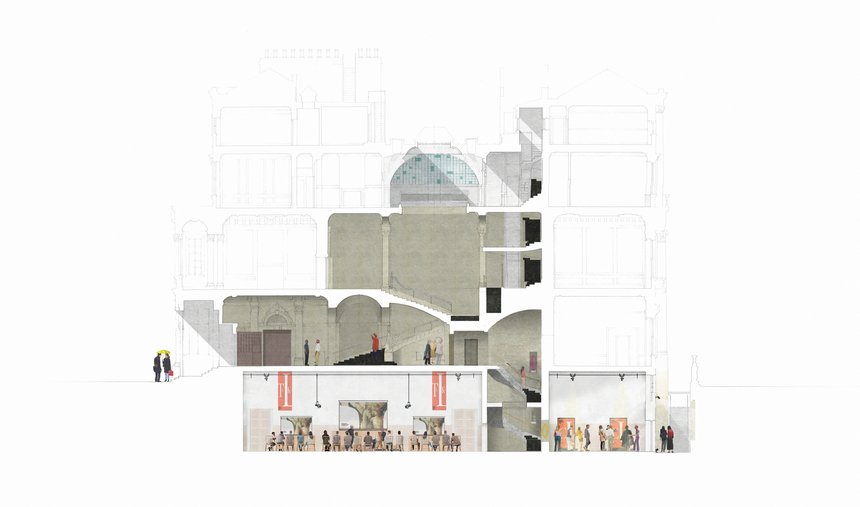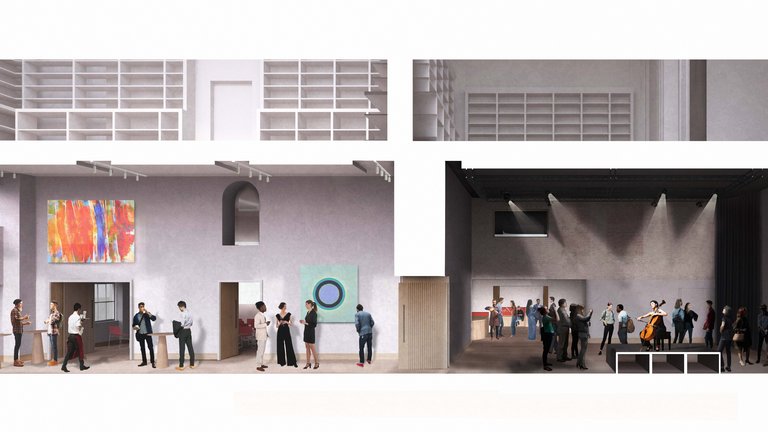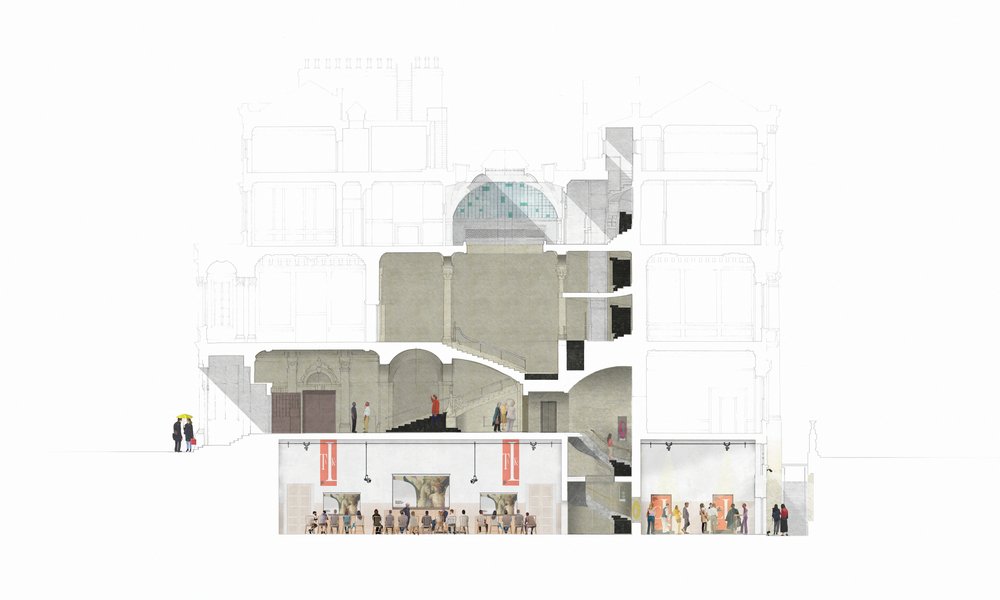Sally Shuttleworth in conversation with Rana Mitter FBA and Matt King-Woodward
Sally: I'm Treasurer of the British Academy and a Professor of English Literature at the University of Oxford. I am also Chair of the British Academy’s Building Transformation Project Board. The Board, which includes a number of Fellows, as well as the architects, Wright & Wright, and technical advisors, has overseen the process of building design, and is now at the exciting stage of overseeing the project during the construction phase. Our planning involved thinking through how the building could be used and the possibilities that would be opened up for British Academy activities and the delivery of our strategic aims. Which brings us to our first question.
Rana and Matt, first of all could you tell us a bit about your roles and how you are involved in planning the British Academy’s events programme?
Rana: I’m Professor of US-Asia Relations at Harvard Kennedy School and a Fellow of the British Academy. I’m the Vice President for Engagement at the Academy and Chair the Communications and Engagement Committee of FBAs and external experts.
Matt: I’m Head of Events and I collaborate with Rana and the Committee to set out our vision and strategy for the programme and work with my team of events professionals on planning and delivery. This includes events, conferences, lectures as well as a new pilot programme ‘SHAPE Involve and Engage’ which provides funding to researchers around the UK to undertake public engagement in partnership with galleries, libraries, archives and museums around the UK.
I was previously at the Academy a number of years ago and re-joined in January 2022 because of the opportunity presented by the transformation programme. Thanks to Wright&Wright’s design and the new AV technology, we will be able to create memorable high-quality experiences for the Academy’s audiences – both those attending in-person and online, which will significantly broaden our reach. We are in the middle of working up the opening programme which will launch around the time of the Summer Showcase in June and continue onwards from September.
Sally: What kinds of different and perhaps unexpected events will the new spaces bring to the British Academy in the opening season next year?
Matt: We have lots of ideas at the moment – from lates (evening events with a variety of activities taking place throughout the building), to performances, film screenings of research outputs, art tours led by FBAs, researcher-led public engagement workshops and debates on current affairs bringing together experts.
As we get used to the new spaces and their technology, we hope to explore more immersive events. We will be returning to themed seasons to tie our work together – these could be anything from Connected Knowledge to climate change, AI and the future of work to children’s rights.
All in all, the new spaces will provide a fantastic platform to reimagine our public events programme and to open up the Academy to new audiences.
Rana: As Matt has mentioned, the opening of the building will bring extra depth and breadth to our events and help us attract new audiences. The British Academy Summer Showcase is our flagship public engagement event and will take place in June 2024. It is essentially an opportunity to present research in a creative way to a broad audience across both the public and private spheres, and in particular illuminating some of the best aspects of how the humanities and social sciences are helping to inform our wider society.
As part of the Summer Showcase, researchers are tasked with developing interactive exhibits so that visitors can take part in meaningful, two-way exchanges with academics and their work. This has involved all sorts of techniques previously, from VR headsets and crafting sessions to role-play and music-making. The new spaces will enable us to show film and photography tied to research using equipment and technology that simply hasn't been at our disposal before.
These new possibilities, and the way we will be able to connect with remote audiences is a new and exciting development for us. It very much reflects our strategic aims to open up the Academy across the UK and the wider world and mobilising our disciplines for the benefit of everyone.
Matt: In our programming we’re especially keen to celebrate the diversity – at many different levels - within SHAPE research and researchers. We’re also looking to find ways to tap into the key issues of today where we can provide objective, independent and evidence-based insights to enhance public understanding and nurture robust and respectful debate.
Rana: In our approach we want to combine pre-planning with the capacity to be responsive to key issues unfolding in the news, where our disciplines have critical insights and expertise to enhance public understanding and discourse, at short notice. At the heart is our ethos that the Academy doesn’t come from any particular angle, and it is not our role to take views and positions - rather our focus is objectivity and advancing knowledge. This reassures those who are looking for insights and information that they know is reliable, that has been properly tested, properly understood and responsibly communicated.

Sally: How will these events increase the outreach of the Academy’s work and showcase the SHAPE disciplines?
Rana: The flexibility of the new spaces benefits us through being able to adapt to the best approach for any one discipline or subject to engage with a wider audience most successfully. That would be a rather different sort of engagement in, say, the study of film or other audiovisual media as compared, let us say, to economics. The technological capabilities of the new venue will allow us to tap into the changing form of the arts.
It may be that the format we use for many events is similar to what we used before, but the new technology powering the redesign will enable us to further our audience reach beyond London and indeed the UK. A live event could be shared in real time using technology to reach remote viewers, and also be used to create content for our website or YouTube channel.
Sally: How are you working with Fellows and staff across the Academy to make plans for the opening season?
Matt: One of our key priorities is to represent the wide variety of work across the Academy whether through the Fellowship, our funded researchers, or the Academy’s Policy and International teams. We’re arranging meetings and workshops with key people inside and outside of the Academy to find out more about their projects and how we can feature them in the events programme and will be inviting Fellows at regular periods to submit their ideas for future seasons. The programme is agreed by the Communications and Engagement Committee, and we’ve recently set up an Events Advisory Group consisting of Fellows who we'll be able to consult throughout the year, in between Committee meetings, to provide us with valuable insights and guidance relating to the programme as it develops.
The Communications and Engagement Committee led by Rana and made up of FBAs plays a vital role in our planning – defining our future direction, our plans for the new programme and also providing ideas for us to explore.
Rana: It’s crucial to remember that the opening is not just an event, it's the start of a process. We're thinking about the first two years and the cycle beyond that. It's very important not only to launch the spaces in the most exciting way possible, but also to make sure that the programme is sustainable over time. And to that end, the continued input of our Fellows and other stakeholders is a very important element.
If you would like to learn more about the plans for our building, contact us on [email protected]



